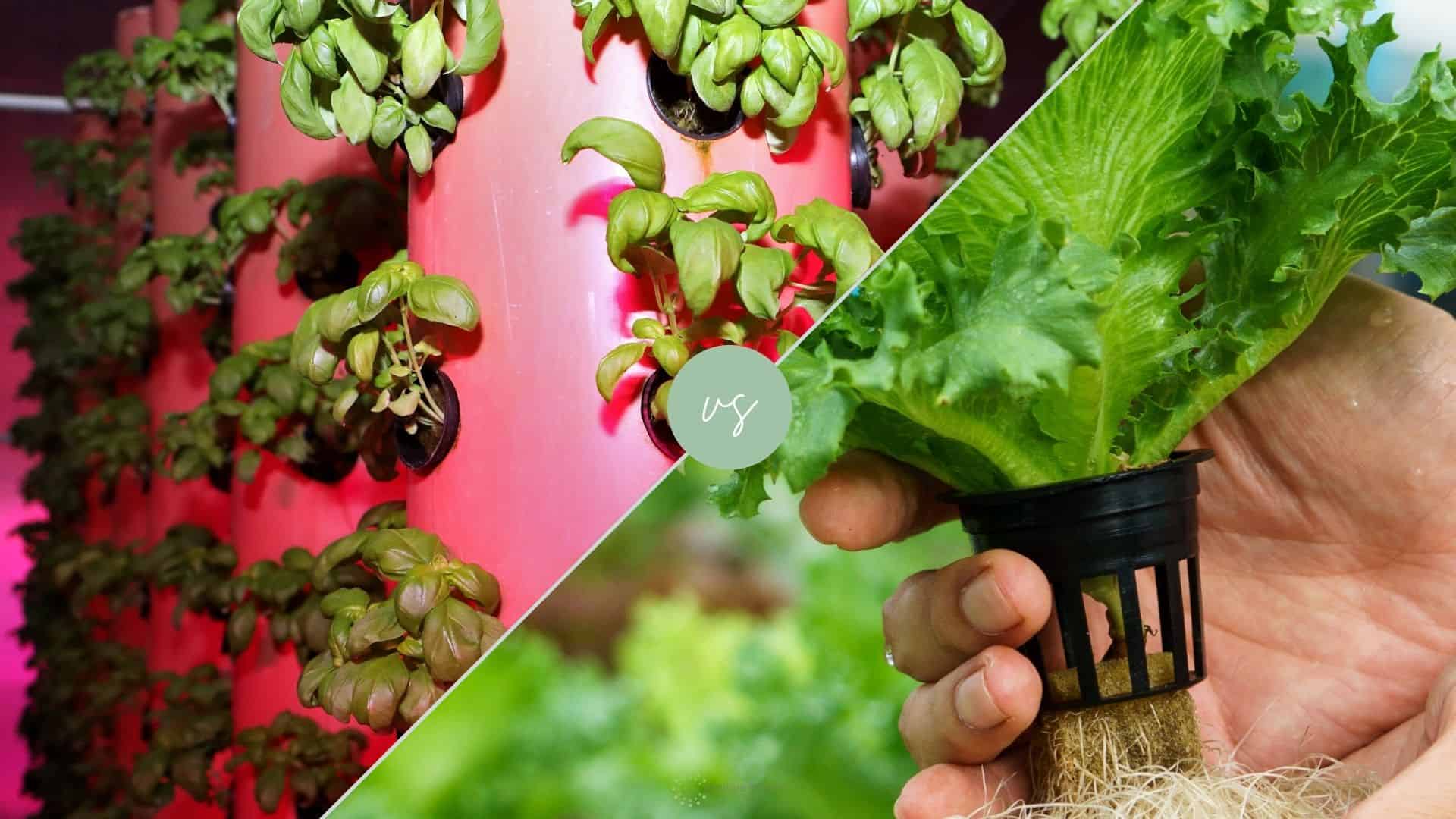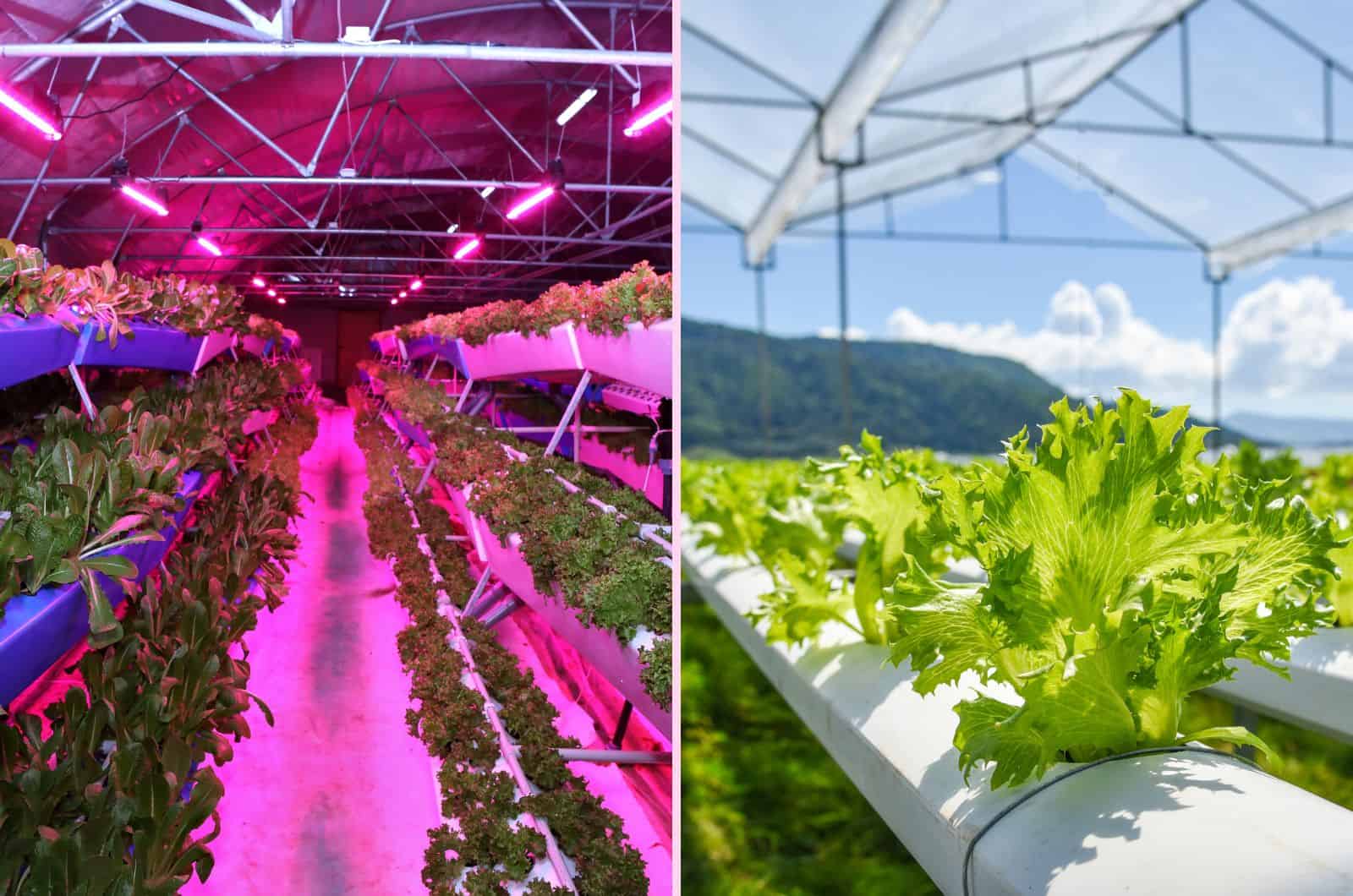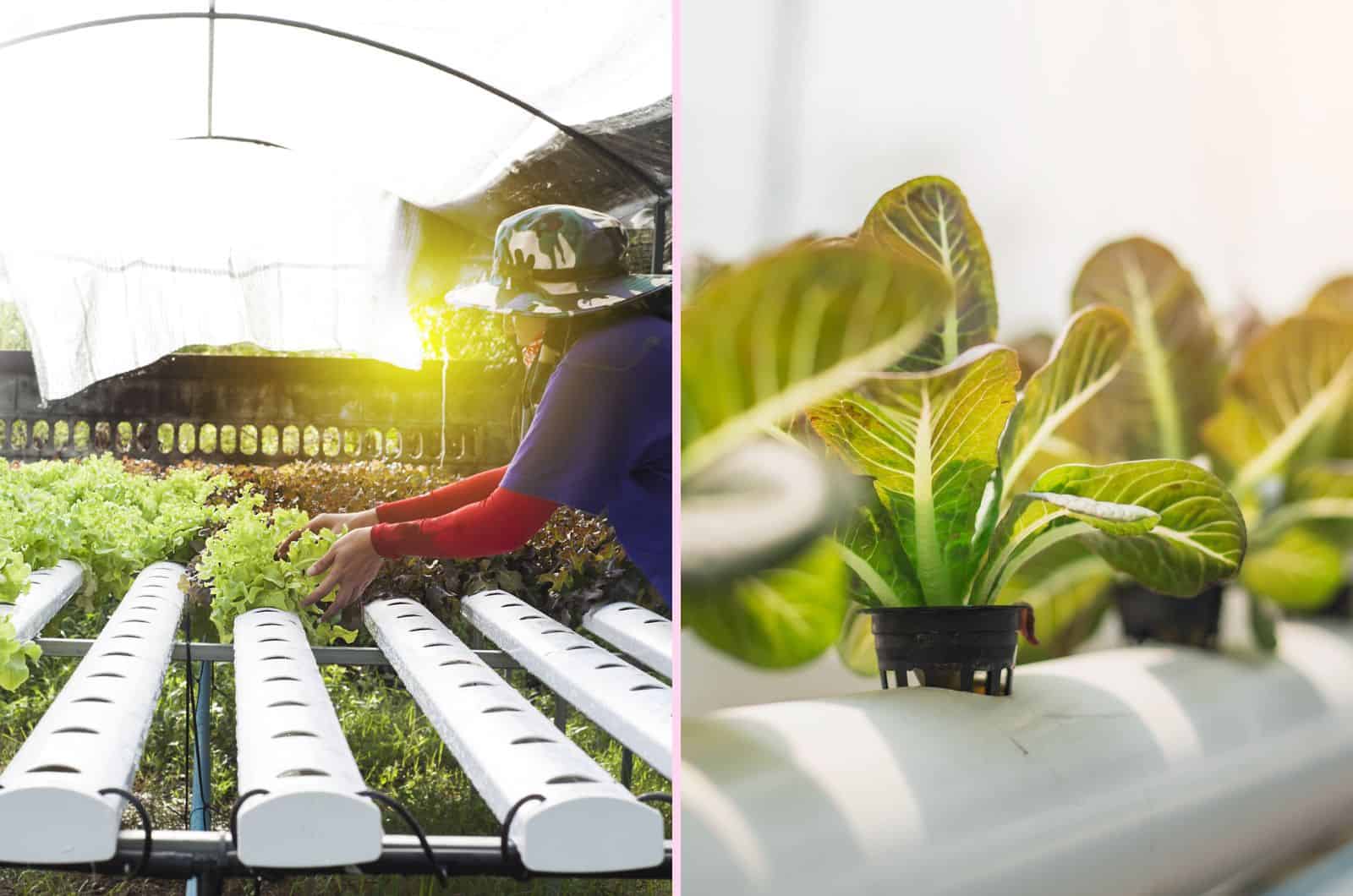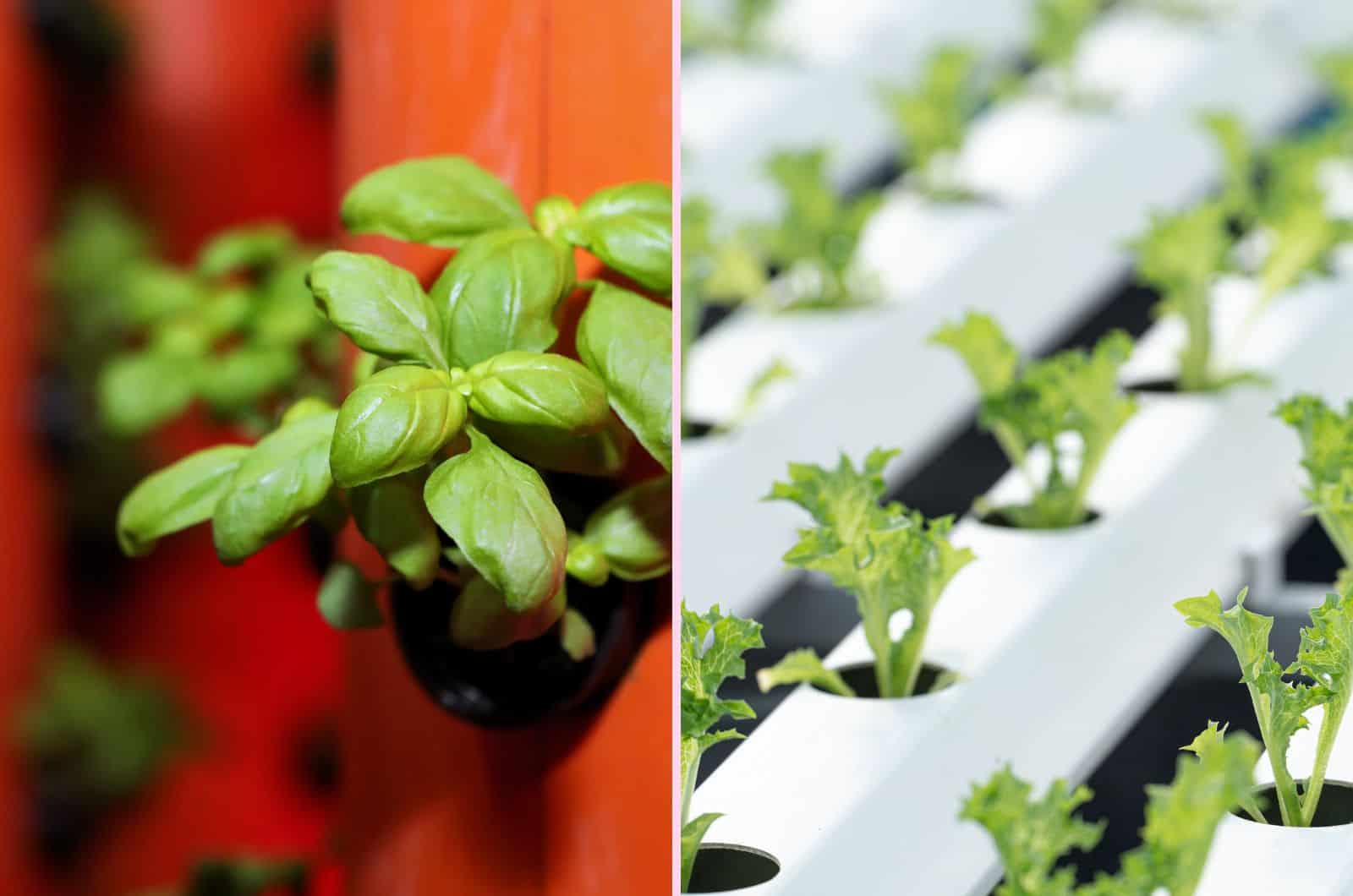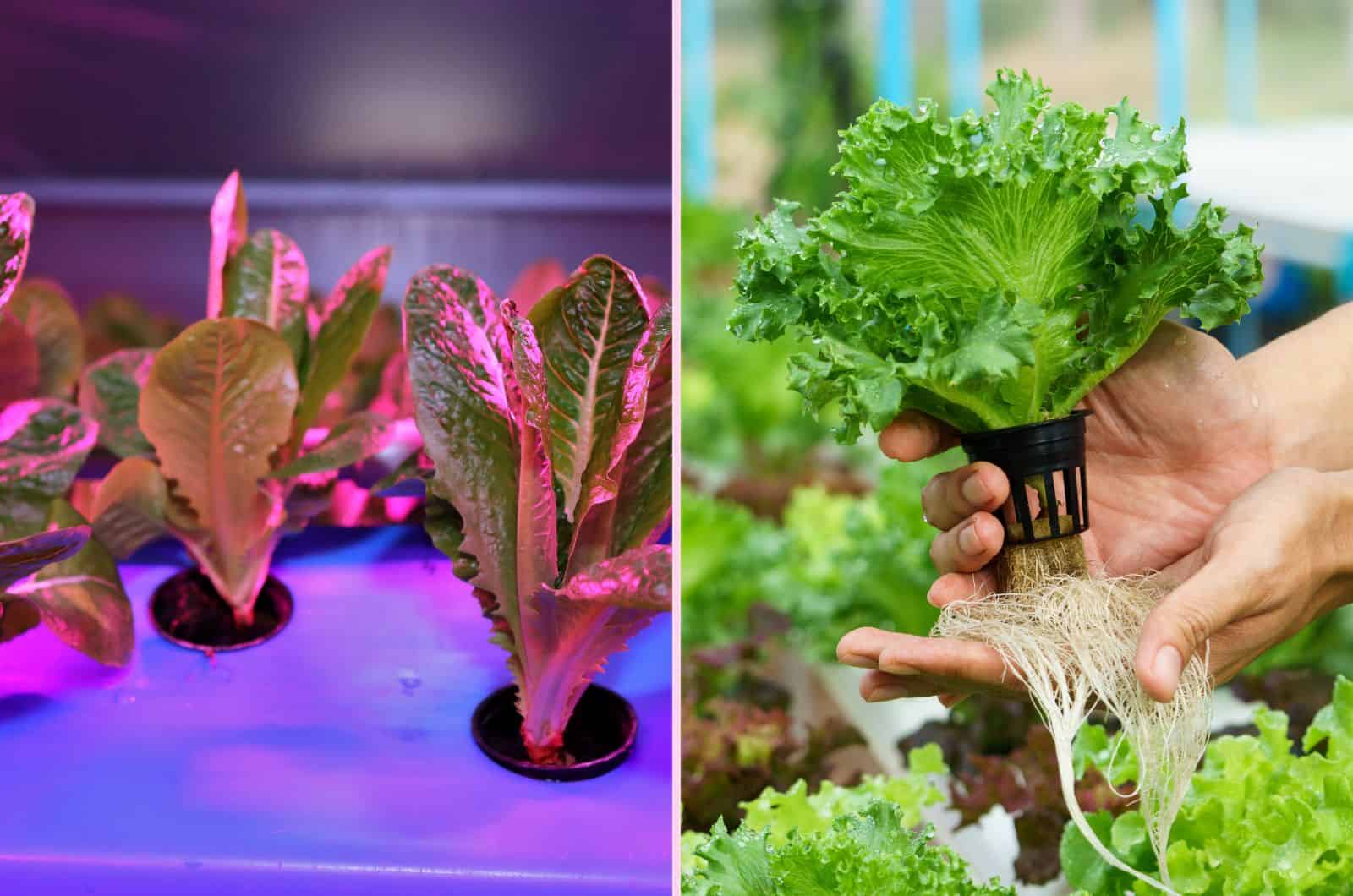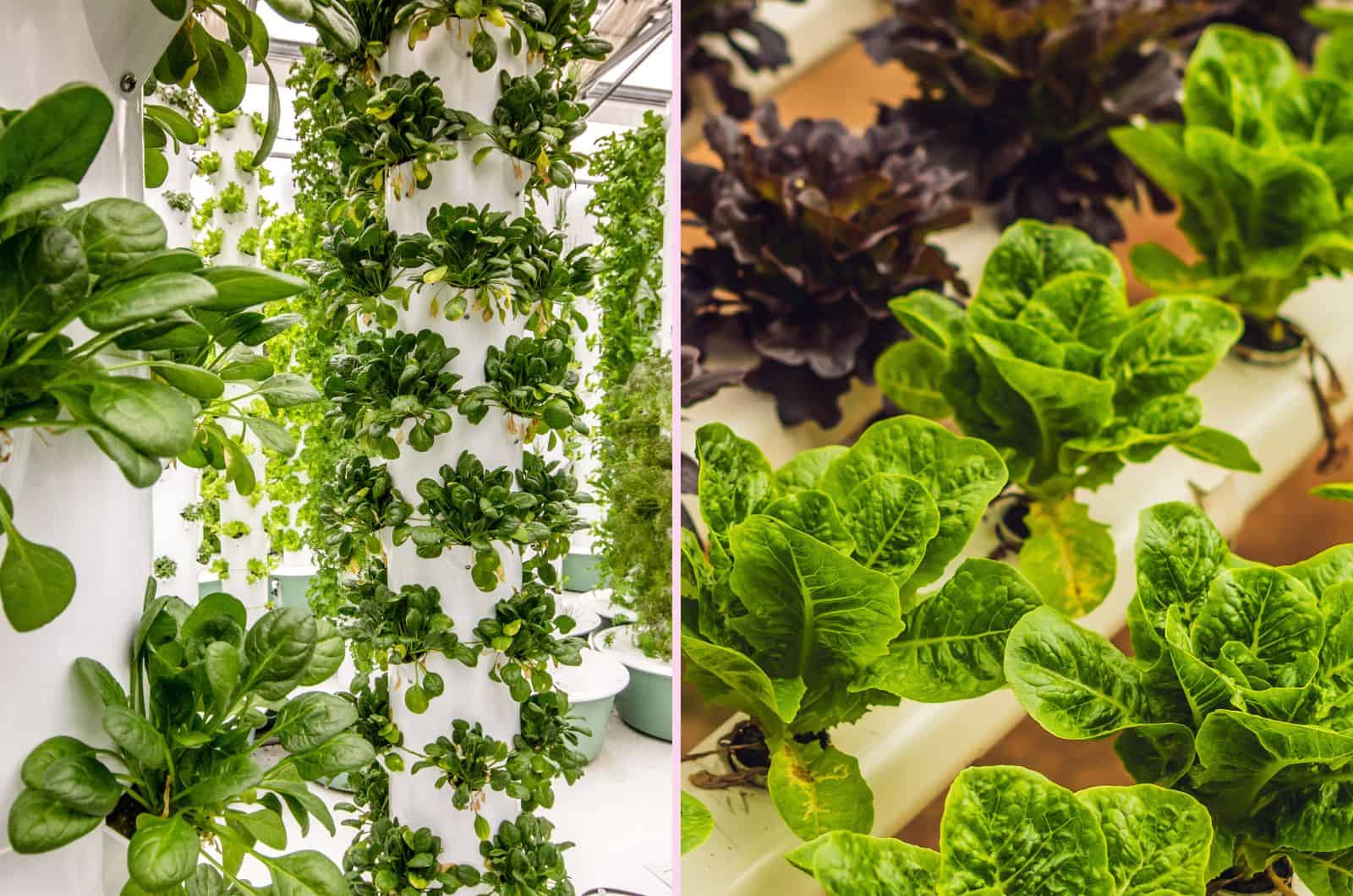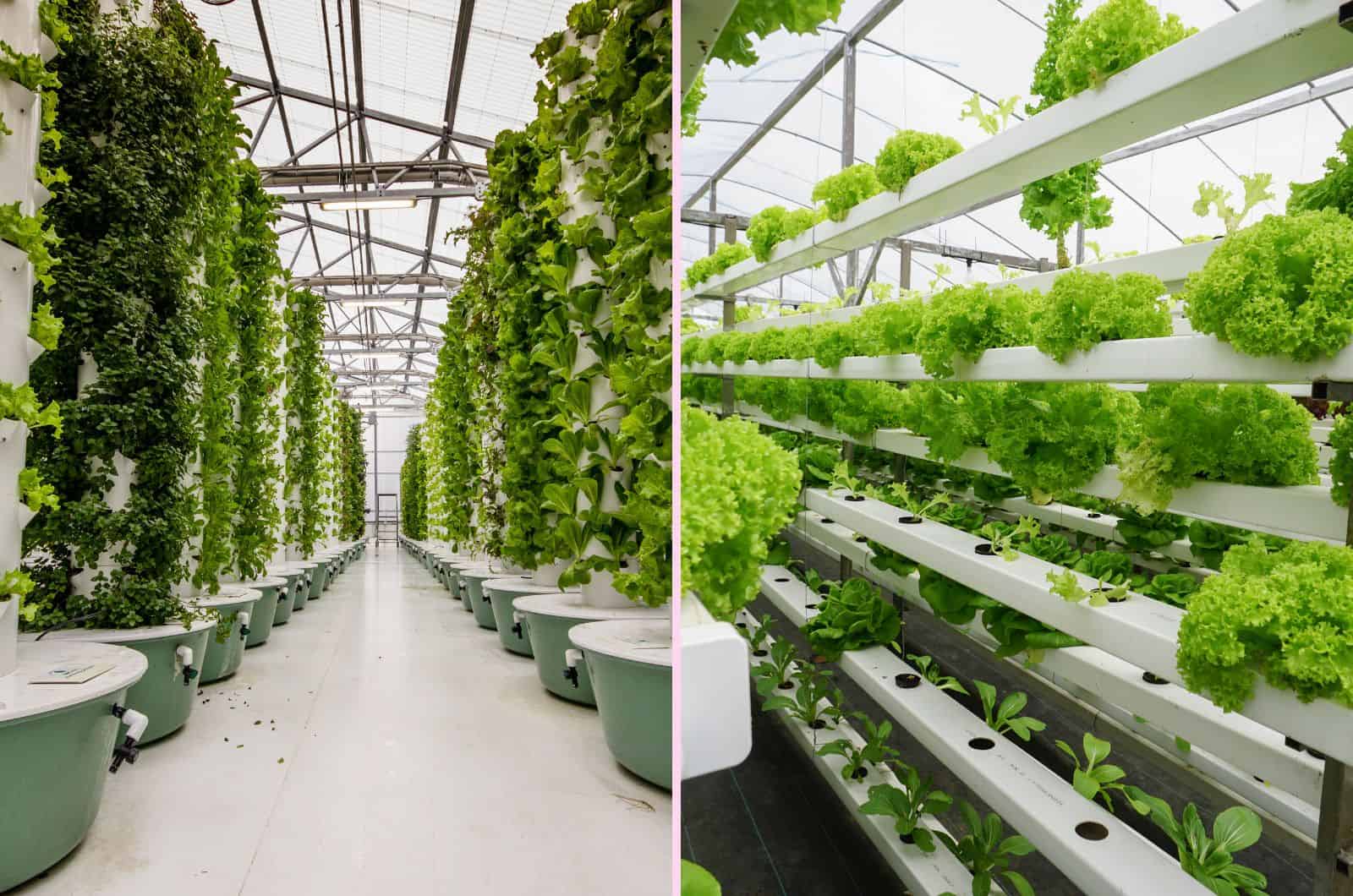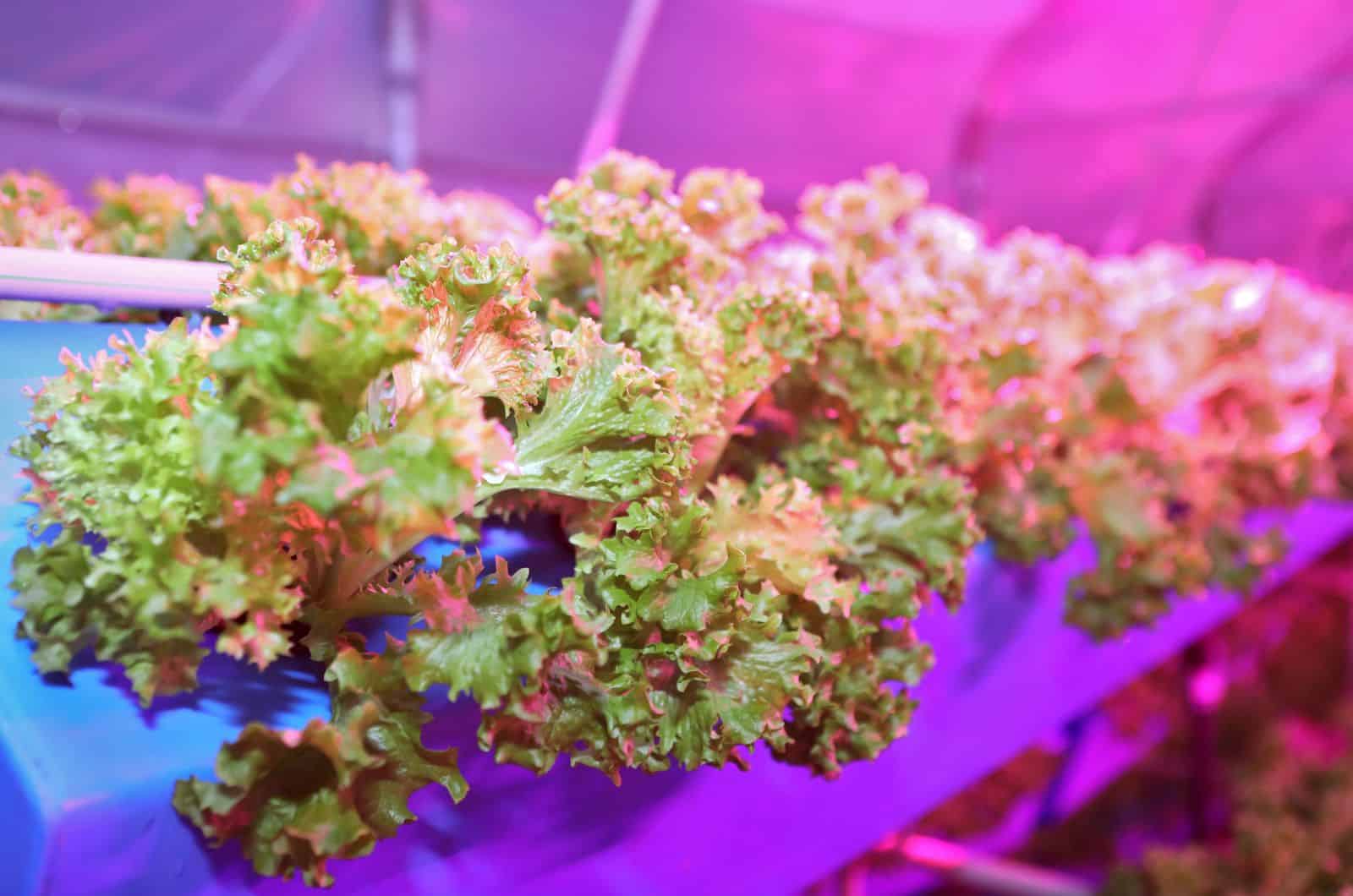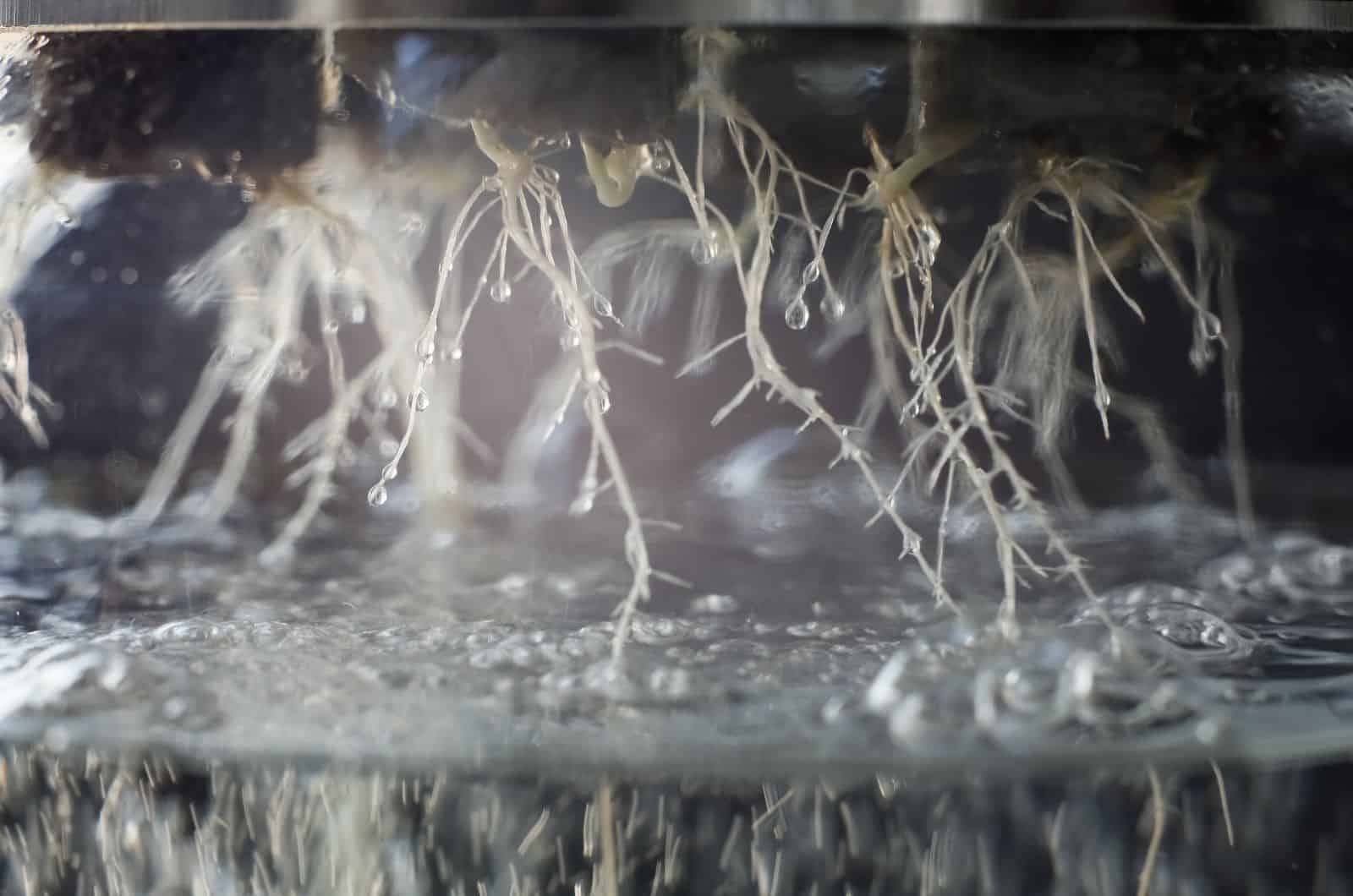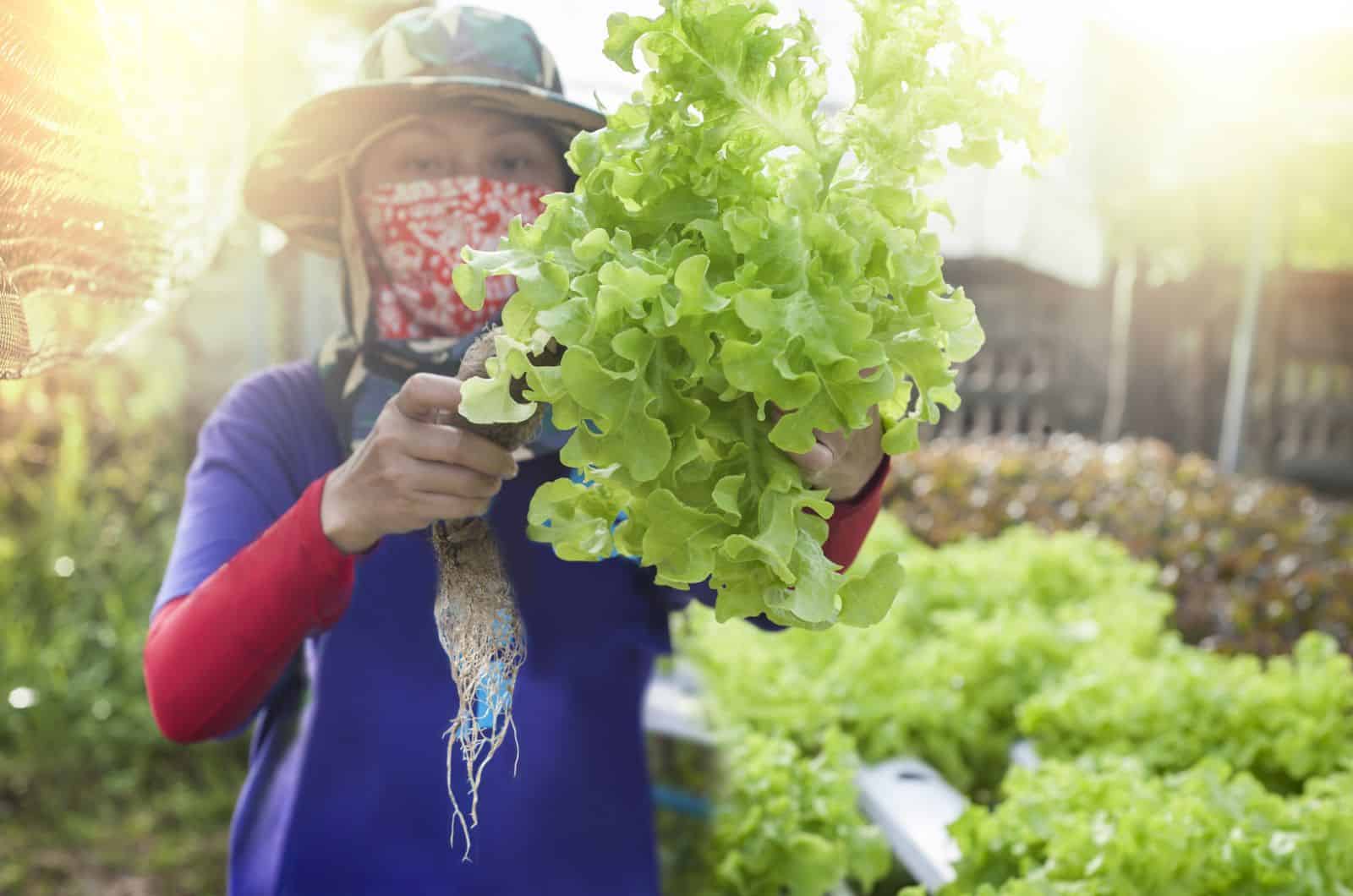Aeroponics and hydroponics are both methods of soilless plant growing. However, in aeroponic farming we mist the plant’s roots with nutrients and moisture, while with the hydroponic gardening method we keep plants submerged in nutrient-rich water.
There are many other differences between these two systems, such as their price, maintenance, water consumption, yield, and benefits on plant health and growth.
We’ll discuss all these factors in the following article, as well as their benefits and drawbacks so that you can choose which method is the best one for your needs.
Which Is Better: Aeroponics vs Hydroponics
In aeroponics, plant roots are exposed and sustained in the air, while in hydroponic farming, the roots are submerged in a nutrient solution.
Of course, there are various hydro methods, such as ebb-and-flow, DWC, NFT, etc., so it’s up to you to decide which one you want to use.
For instance, growing hydroponic tulips is becoming more and more popular, but it is also possible to grow them (and other flowers) in an aeroponic system.
Below, we’ll discuss each farming method individually and then compare them so that you can make an informed decision when deciding between the two.
What Is An Aeroponic System?
Aeroponics is a plant-growing method without any use of soil or growing medium. The roots hang freely in the air, and growers regularly spray them with a nutrient-rich solution.
We frequently find this type of system in greenhouses and indoor gardens because they’re highly effective and sustainable.
You can grow leafy greens, vine plants, root vegetables, microgreens, herbs, and many other veggies in an aeroponic garden.
To set up your aeroponic garden, you’ll need something to suspend plants in the air, a nutrient solution, monitoring devices to measure pH levels, humidity, temperatures, etc., and a misting system.
There are two types of aeroponic systems: high-pressure aeroponics and low-pressure aeroponics, and we’ll talk more about them in the following paragraphs.
Here’s a DIY video that can help you build your very own aeroponic system:
High-Pressure Aeroponics (HPA)
HPA is a method of aeroponic cultivation where we mist the nutrient solution onto the roots of the plants using high-pressure pumps.
The finely atomized nutrient solution allows for a larger surface area of the root system to come into contact with it, increasing the growth of aeroponic plants and their health.
This method helps oxygenate the roots and passes better through the canopy, using less water and nutrients.
Low-Pressure Aeroponics (LPA)
The LPA method uses low-pressure pumps or misters to deliver a nutrient-rich solution and moisture to the plant roots.
The nutrients in this method aren’t as atomized as in high-pressure aeroponics, which is why the drops are larger.
It doesn’t oxygenate the roots as well or efficiently, but the system is simpler and some growers give it an advantage over HPA.
Unlike high-pressure aeroponics, you can use LPA in home gardens and small-scale indoor farms.
What Is A Hydroponic System?
This farming system uses nutrient solutions to grow plants, unlike soil gardening. The water-based liquid contains all the minerals necessary for proper plant development.
There are many hydroponic plants we can grow in this system, such as leafy greens, herbs, vine plants (e.g tomatoes), root crops, beans, strawberries, blueberries, etc.
There are many different hydro systems out there, such as drip irrigation, wicking systems, ebb-and-flow, the Kratky method, deep water culture, etc.
They typically need a tray or some other growing container, a growing medium, a water reservoir, a water solution rich in nutrients, and a delivery system (pumps, tubes, etc.)
Some setups, such as deep water culture, require an air pump and air stone to oxygenate the roots as they’re constantly submerged in the solution.
Finally, you’ll also need to monitor the pH level, liquid, and electrical conductivity (amount of nutrients) of the liquid constantly in order to keep your plants healthy.
Here are some excellent tips for an outdoor hydro system to help you save some money (you won’t have to pay for fans, grow lights, too much electricity, etc.).
How To Choose Between Hydroponics vs Aeroponics
The key difference between hydroponics and aeroponics is that with hydroponics the plant roots are submerged in water either full-time or in intervals, while in aeroponics they’re exposed and suspended in the air.
Of course, there are some other things to take into consideration, such as water consumption, plant growth rate, yield, effect on the environment, cost, maintenance, appearance, etc.
1. Effect On Plant Growth
Generally speaking, aeroponics is at a slight advantage in this category because the plant roots receive more oxygen with this system than with hydroponics.
However, the initial growth rate of plants is faster with hydroponics than aeroponics because aeroponic plants develop roots more slowly. But once their root system establishes, they overtake hydroponic plants in terms of their size.
Finally, the growth rate of aeroponic plants slows down after a month, and hydroponic ones catch them up. Therefore, if you grow annuals, you’ll benefit from an aeroponic system because your plants will grow faster.
2. Effect On Plant Health
When it comes to plant health, we must say that aeroponics is better because plants get more oxygen and develop stronger roots.
With hydroponics, plants are all in the same container (unless you grow them in different ones), which may increase the risk of fungal and bacterial infections. In aeroponics, the solution goes straight onto the roots from the nozzles.
However, both methods work better than soil farming, so give them a go.
3. Crop Production
Even though aeroponic farming produces larger and healthier plants, it doesn’t mean that it has higher yield.
The harvest will greatly depend on the plants you grow, the hydroponics method you use, etc.
For instance, if you grow annuals such as leafy greens and veggies, aeroponics will give larger yields than hydroponics. This system reaches its peak after six weeks, and that’s approximately the time when we harvest these plants.
On the other hand, hydroponic methods such as deep water culture, and similar ones where plants are constantly submerged in water, give a lesser yield. However, the Kratky method has proven to be quite successful, and almost as efficient as aeroponics.
Therefore, growing hydroponic vegetables has its perks, but generally speaking, aero growing systems are more efficient because the plant roots get more oxygen.
4. Less Water Usage
Aeroponic systems typically use less water than hydroponic ones. They utilize a mist or fog of nutrient solution to deliver water and nutrients to the plants, while hydroponic systems use a continuous flow of mineral-rich water solution.
The roots of the plants in aeroponic setups are only in contact with the liquid during the misting cycles, while they’re always in the solution in hydro growing systems.
Because of this, aeroponic systems are more efficient in terms of water usage. They use up to 90% less water than traditional soil gardening, and up to 70% less water than hydroponic systems.
5. Requirements For Growing Medium
Aeroponics doesn’t require the use of a growing medium since the roots aren’t constantly in the water, can breathe on their own, and the nozzles provide equal coverage and efficient delivery of nutrients.
However, in hydro systems you should use some kind of soilless material such as growing hydroponic plants in coco coir, LECA pebbles, Rockwool, etc., to avoid keeping the plant’s roots in water all the time.
These materials support the growth of your fruit, flowers, and veggies, and also ensure the proper delivery of nutrients.
6. Nutrient Absorption
The general consensus is that nutrient absorption is better in aeroponics than hydroponics regarding essential elements such as nitrogen, phosphorus, potassium, calcium, and magnesium.
Of course, many external factors influence absorption, so you have to take care of the amount of nutrients you have dissolved in the water, the pH level of the liquid, weather conditions, growing medium (for hydroponics), etc.
7. Effect On The Environment
Both of these methods are sustainable and environmentally friendly types of urban farming because they don’t use chemicals such as synthetic fertilizers, pesticides, herbicides, etc.
Since neither of them require soil, they reduce the risk of spreading soil-borne diseases.
But between the two, aeroponics is more green as it uses 70% less water than hydroponics. It also reduces the use and waste of nutrients.
However, hydroponics is more environmentally friendly in terms of energy usage. Aeroponics, especially HPA, constantly needs electricity, while hydroponics doesn’t.
You can even move your hydro systems outside and use solar energy and wind instead of electricity.
8. Growing Environment
When talking about open and closed environments, aero and hydro systems clearly differ. Aeroponics always requires a closed environment, while some hydroponic setups are open.
But what are their benefits and drawbacks?
All research suggests that closed environments are better as they prevent evaporation and reduce the risk of drying out the plants’ roots.
They reduce algae spread and maintain clean water and a proper temperature for the roots.
Therefore, growing hydroponic carrots (or any other veg) in a closed environment will be easier and more suited for beginners since you won’t have to worry about any of the things mentioned above.
9. Indoors vs Outdoors
You can adapt your hydroponic system to outdoor or indoor conditions easily, and your plants will thrive in both settings. In fact, you’ll spend less money on artificial lights and fans if you move it outside.
Aeroponic setups, on the other hand, are more suitable for indoors because it is quite difficult to maintain them outside.
The conditions inside the aero system need to be perfect, and the temperature fluctuations, lighting, and inconsistent wind and humidity levels can hurt your plants.
It is hard to maintain the balance when the conditions constantly change, so it’s best to keep the aeroponic system indoors.
10. Cost
Aeroponics systems are more expensive because they require specialized equipment such as high-pressure pumps and nozzles for the mist, which cost more than the simple water and nutrient delivery systems used in hydroponic setups.
(You can set up a hydro garden with some PVC pipes or a plastic tank and a couple of cheap pumps.)
Aeroponic systems also don’t require any growing medium; instead they need special equipment, which makes hydroponics a less expensive choice.
The cost of building and maintaining an aeroponic system is higher because it is more complex and requires more precise control over the environment, also adding to the expenses.
Furthermore, high-pressure pumps in aeroponics need to be on all the time and they use a lot of energy, which only adds to the monthly bill.
However, aeroponic systems require and waste less water and nutrients than hydroponics, so you might save a couple of bucks there.
All in all, if you want to save money then hydroponics is the way to go!
11. Maintenance
It is much easier to maintain a hydroponic system as they aren’t completely dependent on electricity like aeroponics, and are less sensitive to changes. (If the high-pressure pump stops working for just a bit, for instance, it can be detrimental to the plants).
Also, maintaining proper temperature and humidity levels inside an aeroponics setup is much more difficult than keeping the water cool for the hydroponics one (where you can add cold water or ice).
For instance, if the humidity gets too high, it can lead to the spread of fungi, mildew, mold, and other similar issues.
The growing medium inside the hydro system supports the plant’s roots, serves as a buffer, retains moisture and nutrients, and can help maintain pH levels.
Furthermore, the nozzles and entire misting system can clog, so you’ll have to monitor it more closely than pumps in hydroponics.
12. The Pump
The main difference in pumps between aeroponics and hydroponics setups is the purpose and method of delivery of the nutrient solution.
Aero systems use a high-pressure pump to create a fine mist of nutrients that they deliver to the plant roots.
In hydroponics, we use submersible water pumps to bring a continuous flow of the nutrient solution to the plants. They push the liquid through a tubing system and deliver it to your fruit, flowers, and vegetables.
Aeroponic systems require more powerful pumps, so their size and capacity also differ – hydroponic setups usually need smaller pumps.
13. Suitable For Beginners
When it comes to simplicity, the hydro system wins the round. It is less complicated to set up, and you can control and monitor it more easily than the mist, nozzles, and all other equipment in aeroponics.
Hydroponics also uses growing mediums that can help support your plants and make the transition from soil farming to using aero or hydro systems easier.
Also, the PSI pump in aeroponics is much more complicated to set up and maintain, as you have to ensure that the size of the pipe, nozzles, and strength of the pump are suitable for your plants.
14. Appearance
It really depends on the individual person and their preferences when it comes to which growing system looks more appealing.
We usually don’t see the exposed roots of aeroponic plants, and the equipment gives off a modern and minimalistic vibe. You can even use clear tubes and tanks to display the entire plant and the solution.
Hydroponic systems look more traditional due to the use of growing mediums and roots submerged in liquid. You can set it up in natural materials and arrange the plants to mimic the environment, especially when growing hydroponic flowers.
Advantages And Disadvantages Of Aeroponics
There are many benefits to owning an aeroponic system.
• This setup ensures better nutrient absorption and oxygenation of plant roots, resulting in improved growth, health, and higher yield.
• It uses less water and reduces the waste of moisture and minerals.
• It is more appealing and minimalistic, saving space at the same time.
• The aeroponic system doesn’t require a growing medium.
• You can adapt it to suit a variety of plants.
Unfortunately, it does have drawbacks:
• Aeroponic systems are more expensive than hydroponics and require constant monitoring.
• It is more difficult to set up than soil farming and hydroponics, making it less desirable for beginners.
• It is much more difficult to maintain an aeroponic growing system than a hydro one.
• This setup requires many pumps, which are complicated to set up and maintain.
• Aeroponic systems require more energy than hydroponic ones to operate properly.
• They completely depend on technology and electricity, and a power outage or pump malfunction can damage or kill plants.
• Aeroponics depends on the climate, so it’s not suitable for outdoors or regions with high humidity.
Advantages And Disadvantages Of Hydroponics
Hydroponics also has its pros, including:
• You can easily control conditions such as temperature, humidity, light, and mineral levels.
• Less pricey to set up than aeroponics, and uses less power.
• Easier to maintain, and has simple pumps that are cheap, easy to set up, and keep.
• You can make one yourself from PVC pipes or plastic tanks and cheap pumps.
• You can adjust for indoor and outdoor settings.
• It doesn’t solely depend on electricity (especially if you move it outside).
• Promotes water recycling.
Hydroponics also has its cons when compared to aeroponics:
• It usually looks less attractive, especially if made from pipes.
• Since plant roots are submerged in water, they’re more prone to fungal diseases and water-borne infections.
• Plants don’t get as much oxygen, so they exhibit slower growth, slightly poorer health, and smaller yields.
• Hydroponic systems require a growing medium, and use more water and nutrients than aeroponic ones.
• They usually require more space, but that depends on the amount of plants you grow.
Final Thoughts
Aeroponics and hydroponics are both types of urban farming in which plants are grown without soil.
The key difference between these two methods is that aero setups mist the plant roots that hang from above, while the plants are in the nutrient solution in hydro systems.
When we compare aeroponics vs hydroponics side by side, we can see that the former looks more appealing, promotes a faster growth rate and healthier plants, has higher yields, and uses less moisture and minerals.
Hydroponics, on the other hand, is cheaper and uses less energy, is easier to set up, you can build it yourself easily, is easier to maintain and control the growing conditions for plants, can be moved outdoors, and doesn’t solely depend on electricity like aeroponics.
Both of these systems have their benefits, and it’s up to you and your personal needs when it comes to choosing between the two.
Until next time!

